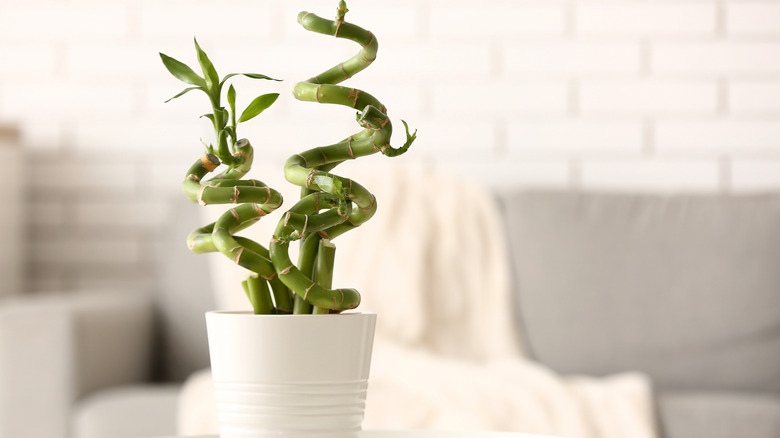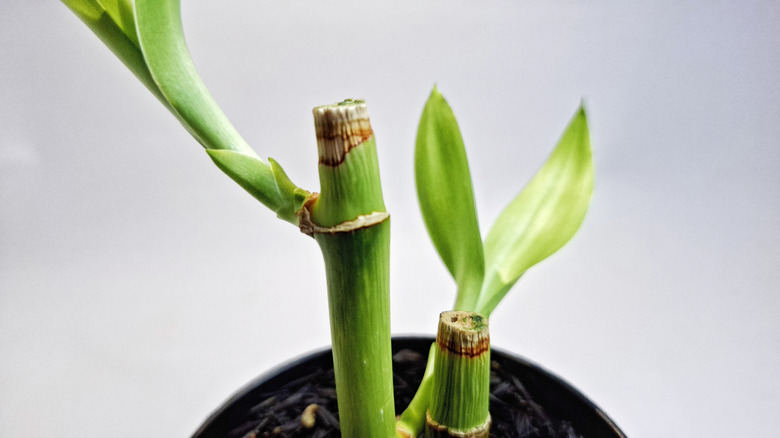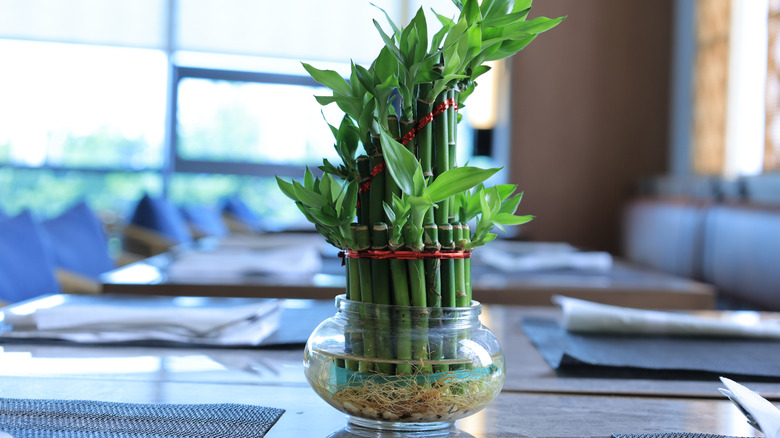Must Know Tips For Growing Lucky Bamboo Plants In Soil And Water
There are hundreds of genera and thousands of species of bamboo out there. But when it comes to indoor houseplants, one is the clear frontrunner, showing up in homes, offices, and lobbies all around the world — and it's not even a true bamboo. Lucky bamboo (Dracaena sanderiana) grows in upright canes with shoots at the top, so it looks like bamboo, but it's actually a shrub in the asparagus family. Meanwhile, true bamboos are a type of grass. True bamboos prefer to grow outdoors and in soil, whereas lucky bamboo can happily grow indoors in either soil or water.
Lucky bamboo is popular for a few reasons. First, it's associated with prosperity, making it a common gift as well as a popular addition for Feng Shui purposes. Though it grows up to 5 feet in height in the wild, it's usually sold in compact forms that can be trained into various shapes, including braids, twists, hearts, or swirls. It's also easy to take care of bamboo plants; they require minimal attention while providing a bright burst of green to your space.
Whether you grow bamboo plants in soil or water, it's important to find the perfect spot for it. Direct light may cause the bamboo leaves to turn yellow or result in algae developing in water; lucky bamboos prefer bright, indirect light. They will also tolerate low light, but they won't grow as quickly. Additionally, lucky bamboos are native to Africa and prefer room-temperature, humid conditions. They'd be happy in one of the more humid rooms in your home, like the kitchen or bathroom. In drier areas, add a pebble tray or mist occasionally.
How to successfully grow lucky bamboo in soil
Lucky bamboo stays alive longer when grown in soil. It requires plenty of nutrients, so use a well-draining, fertile potting mix or houseplant compost. The soil should be consistently moist but not soggy. Water about every week to week and a half, or when the top inch of the soil is dry to the touch. Fertilizing a lucky bamboo in soil is simple: Every four to six weeks during the growing season, dilute a balanced houseplant fertilizer to half strength and apply it to your lucky bamboo.
The plant might become top-heavy eventually, but you can alleviate this imbalance by trimming it down; just make sure you cut the offshoots at the top, not the canes. You can also train the plant to grow in a certain direction by turning it towards the light; one method is to use a cardboard box to prevent the plant from accessing light except from one open side. By switching sides, you can even get your plant to spiral.
If you want to grow your lucky bamboo in a pot outdoors, you can do so as long as you're mindful of its climatic preferences. Lucky bamboo is hardy in USDA zones 10 to 12, so it can survive winters in the nation's warmer regions. In other areas, it's best to keep these plants indoors year-round or bring them in when it gets cold out.
Tips for growing lucky bamboo in water
Lucky bamboo will live for one to two years in water, and this method allows you to get a bit creative with your choice of container, since no drainage is necessary. Add rocks or pebbles to the container to anchor it and prevent tipping. Only the roots and the base of the plant should be submerged.
When growing lucky bamboo without any soil, your choice of water makes the biggest difference in the plant's health. It will tolerate regular tap water, but chemicals like fluoride and chlorine can harm the plant or cause the leaves to turn brown. Instead, opt for distilled, filtered, bottled, or rainwater, or let your tap water sit for 24 hours so the fluoride and chlorine can dissipate. Once a week, drain the lucky bamboo's container and add fresh water. To fertilize, generously dilute a balanced liquid fertilizer and add it to the water every two months.
If you bought a lucky bamboo plant in a fun shape, it's best to leave any ties or tape on the plant just in case, as the design may or may not stay intact without this support. Once the plant's roots start to become overcrowded, you have two choices — repot into a slightly bigger container or carefully trim the roots.


